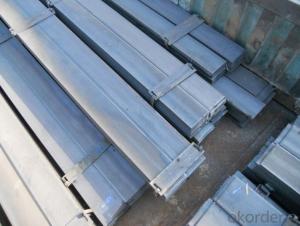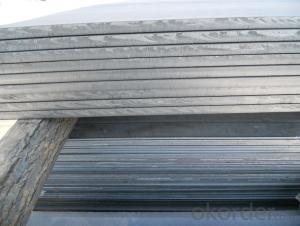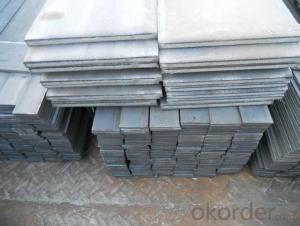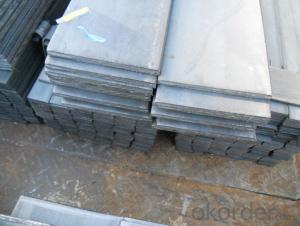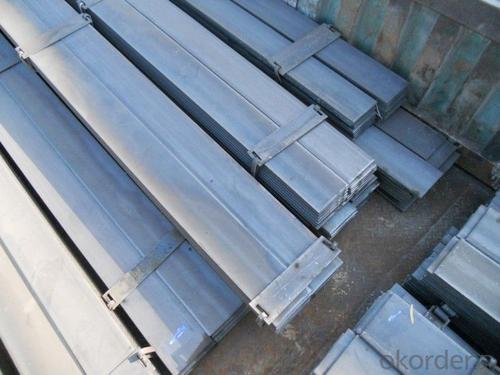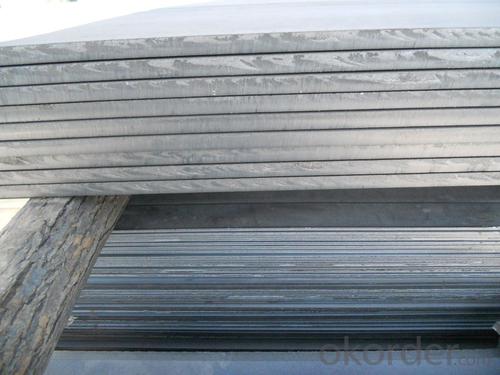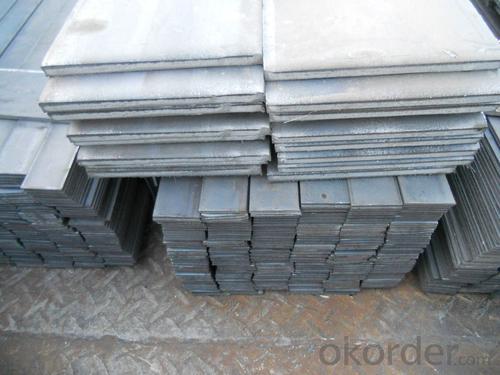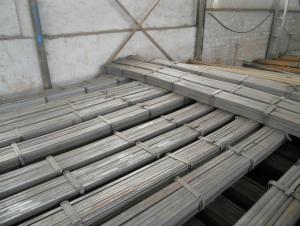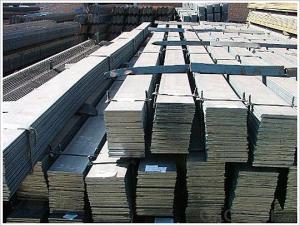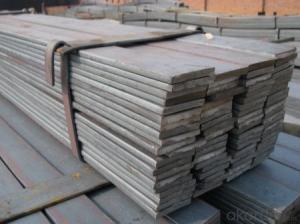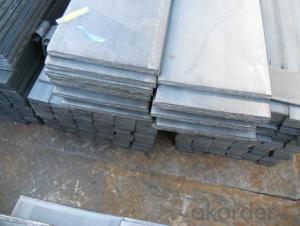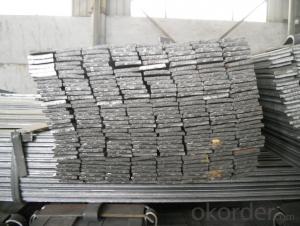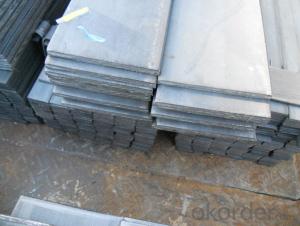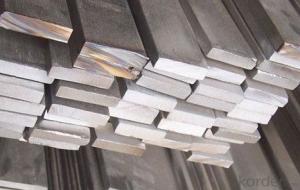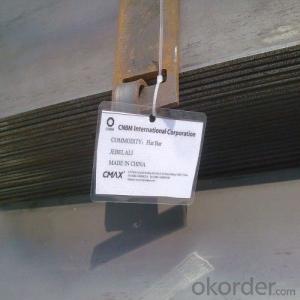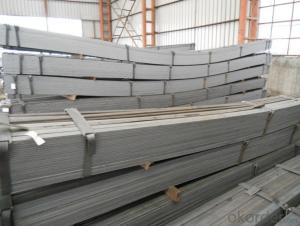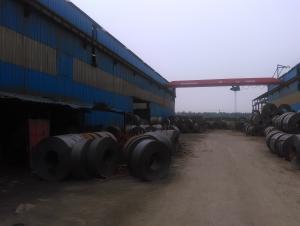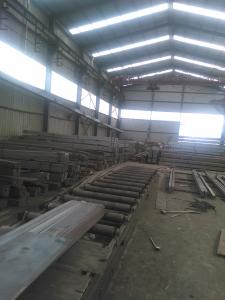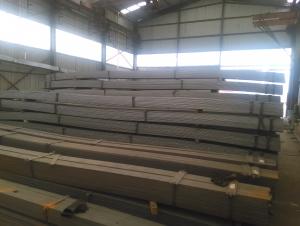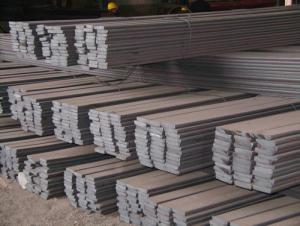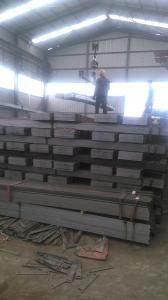Hot Rolled Seel Flat Bars with Material Grade Q235
- Loading Port:
- Tianjin
- Payment Terms:
- TT OR LC
- Min Order Qty:
- 25 m.t.
- Supply Capability:
- 10000 m.t./month
OKorder Service Pledge
OKorder Financial Service
You Might Also Like
Product Description:
OKorder is offering high quality Flat Bar at great prices with worldwide shipping. Our supplier is a world-class manufacturer of steel, with our products utilized the world over. OKorder annually supplies products to European, North American and Asian markets. We provide quotations within 24 hours of receiving an inquiry and guarantee competitive prices.
Product Applications:
Flat Bars are ideal for structural applications and are widely used in the construction of buildings and bridges, and the manufacturing, petrochemical, and transportation industries.
Product Advantages:
OKorder's Flats Barare durable, strong, and resist corrosion.
Main Product Features:
· Premium quality
· Prompt delivery & seaworthy packing (30 days after receiving deposit)
· Corrosion resistance
· Can be recycled and reused
· Mill test certification
· Professional Service
· Competitive pricing
Product Specifications:
Manufacture: Hot Rolled
Grade: Q195 – 235
Certificates: ISO, SGS, BV, CIQ
Length: 6m – 12m, as per customer request
Packaging: Export packing, nude packing, bundled
Chemical composition of Q235
Alloy No | Grade | Element(%) | ||||
C
| Mn
| S
| P
| Si
| ||
Q235
|
B
|
0.12—0.20 |
0.3—0.7 |
≤0.045 |
≤0.045
|
≤0.3
|
Physical properties of Q235
Alloy No | Grade | Yielding strength point(Mpa) | Tensile strength (Mpa) | Elongation after fracture(%) | ||||||
Thickness (mm) | Thickness (mm) | |||||||||
≤16 | >16--40 | >40--60 | >60--100 | ≤16 | >16--40 | >40--60 | >60--100 | |||
≥ | ≥ | |||||||||
Q235 |
B |
235 |
225 |
215 |
205 |
375--500 |
26 |
25 |
24 |
23 |
FAQ:
Q1: How soon can we receive the product after purchase?
A1: Within three days of placing an order, we will begin production. The specific shipping date is dependent upon international and government factors, but is typically 7 to 10 workdays.
Q2: How do we guarantee the quality of our products?
A2: We have established an advanced quality management system which conducts strict quality tests at every step, from raw materials to the final product. At the same time, we provide extensive follow-up service assurances as required.
Q3: The products are invoicing on theoritical weight or on actual weight basis ?
A3: We can do it in both manners, according to buyers' requiremnet.
Images:
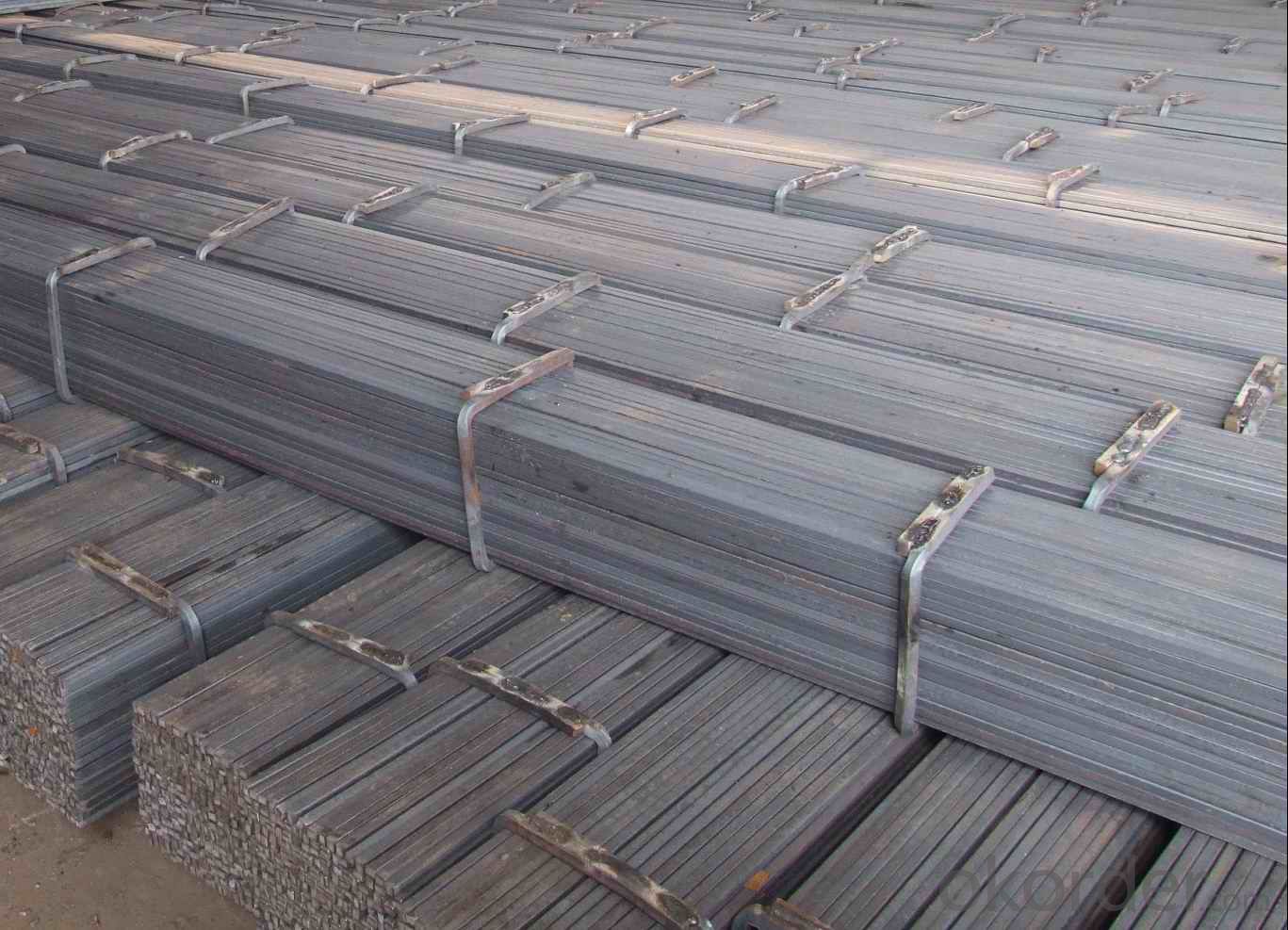
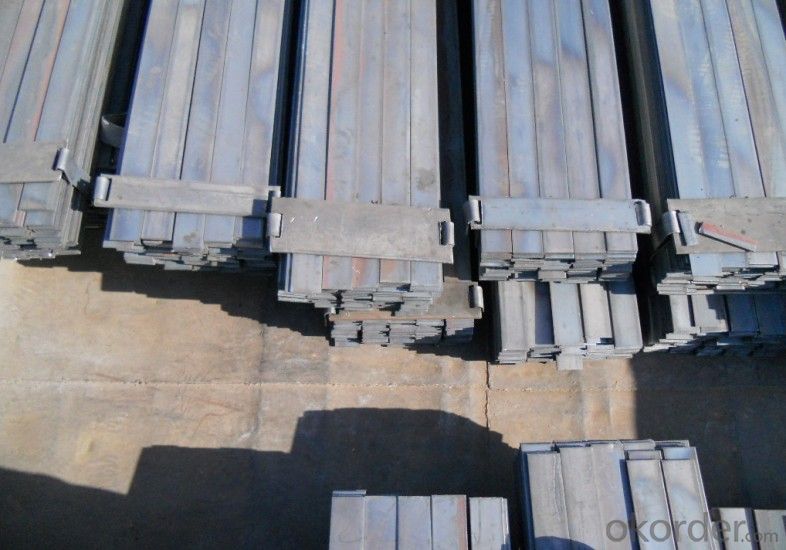
- Q: What is the typical price range for steel flat bars?
- The typical price range for steel flat bars can vary depending on factors such as size, thickness, and the current market conditions. However, as a general guideline, the price range for steel flat bars can range from around $10 to $50 per foot.
- Q: How do you prevent warping or distortion of steel flat bars during heat treatment?
- To prevent warping or distortion of steel flat bars during heat treatment, several measures can be taken. Firstly, it is crucial to ensure that the bars are properly supported and evenly heated throughout the process. This can be achieved by using fixtures or jigs that hold the bars securely in place. Additionally, employing an appropriate heating technique, such as slow and uniform heating, can help minimize the risk of warping. It is also important to control the cooling process after heat treatment. Gradual and controlled cooling methods, such as furnace cooling or air cooling in a controlled environment, can help prevent rapid temperature changes that could lead to distortion. Lastly, proper handling and storage of the bars after heat treatment, including avoiding excessive stress or pressure, can further minimize the potential for warping or distortion.
- Q: Can steel flat bars be cold worked or hot worked?
- Steel flat bars can be both cold worked and hot worked, depending on the desired outcome. Cold working refers to the process of shaping or forming the steel at room temperature through techniques such as rolling, bending, or drawing. This method is commonly used to improve the strength and hardness of the steel, as well as to achieve precise dimensions and smooth surfaces. On the other hand, hot working involves shaping or forming the steel at elevated temperatures, typically above its recrystallization temperature. This process allows for greater plasticity and easier deformation of the steel. Hot working methods include forging, extrusion, and hot rolling. It is often used to produce complex shapes, reduce internal stresses, and enhance the material's grain structure. The choice between cold working and hot working steel flat bars depends on various factors, such as the desired mechanical properties, the complexity of the shape, and the equipment and resources available. Cold working is generally preferred for smaller-scale operations and when precise dimensions and surface finish are crucial. Hot working is more suitable for larger-scale production and when the steel needs to be shaped into intricate or complex forms.
- Q: What are the common methods of surface protection for steel flat bars?
- There are several common methods of surface protection for steel flat bars. These methods are employed to prevent corrosion and extend the lifespan of the steel flat bars. One common method is the application of a protective coating. This can be done through processes such as galvanizing, where a layer of zinc is applied to the surface of the steel flat bar. This zinc coating acts as a sacrificial layer, protecting the steel from corrosion. Another coating option is painting, where a layer of paint is applied to the surface. The paint acts as a barrier, preventing moisture and other corrosive elements from reaching the steel. Another method of surface protection is the use of corrosion inhibitors. These inhibitors are often applied as a thin film or coating on the surface of the steel flat bar. They work by forming a protective layer that inhibits the corrosion process. Corrosion inhibitors can be applied by spraying, brushing, or dipping the steel flat bars into a solution containing the inhibitor. Additionally, some steel flat bars are protected through the process of metal plating. This involves applying a thin layer of a different metal, such as chrome or nickel, onto the surface of the steel. The plating serves as a protective barrier, preventing corrosion and enhancing the aesthetics of the steel flat bar. Lastly, another method of surface protection for steel flat bars is mechanical surface treatments. These treatments include processes such as shot blasting or sandblasting, where small abrasive particles are propelled at high speeds to remove any rust or surface contaminants. This helps to create a clean and smooth surface, ready for further protection, such as painting or coating. Overall, the common methods of surface protection for steel flat bars include protective coatings, corrosion inhibitors, metal plating, and mechanical surface treatments. The choice of method depends on factors such as the intended use of the steel flat bars, environmental conditions, and aesthetic requirements.
- Q: Are steel flat bars suitable for outdoor use?
- Indeed, steel flat bars prove to be fitting for outdoor utilization. The durability and corrosion resistance of steel render it an impeccable selection for outdoor purposes. In fact, steel flat bars exhibit the ability to endure severe weather conditions, such as rain, snow, and extreme temperatures, without succumbing to rust or deterioration. Consequently, they are frequently employed in construction, fencing, and various outdoor structures. Furthermore, to heighten their resistance to corrosion and prolong their lifespan, steel flat bars can be coated with protective finishes, such as galvanization or powder coating. Ultimately, steel flat bars emerge as a dependable and enduring choice for outdoor use.
- Q: What are the dimensions of a standard steel flat bar?
- The dimensions of a standard steel flat bar typically vary depending on the manufacturer and the specific application. However, common dimensions for a standard steel flat bar range from 1/8 inch to 1 inch in thickness and 1/2 inch to 12 inches in width. The length of the bar can vary but is often around 20 feet.
- Q: How do you determine the length of a steel flat bar?
- In order to ascertain the length of a steel flat bar, one may employ a measuring instrument such as a tape measure or a ruler. Begin by positioning one end of the measuring tool at the starting point of the flat bar, then proceed to extend it along the entirety of the bar until reaching the opposite end. It is crucial to maintain the measuring tool in a straight manner and aligned with the edges of the bar to ensure precise measurement. Upon reaching the conclusion of the process, consult the measurement exhibited on the measuring tool to ascertain the length of the steel flat bar.
- Q: Are steel flat bars resistant to impact or shock?
- Yes, steel flat bars are generally resistant to impact or shock due to their high tensile strength and durability. They are commonly used in applications where resistance to impact or shock is required, such as construction, manufacturing, and structural projects.
- Q: Can steel flat bars be used for manufacturing conveyor systems or belts?
- Yes, steel flat bars can be used for manufacturing conveyor systems or belts. Steel flat bars are often used as support structures or frames in conveyor systems. They provide a sturdy and durable base for the conveyor belts to run on. The flat surface of the steel bars allows for smooth movement of the belts, ensuring efficient and reliable transportation of goods or materials. Additionally, steel is known for its strength and resistance to wear and tear, making it an ideal choice for conveyor systems that require heavy-duty operations. Overall, steel flat bars are a suitable material for manufacturing conveyor systems or belts due to their strength, durability, and smooth surface.
- Q: Can steel flat bars be used for creating shelving or storage systems?
- Steel flat bars are versatile materials that can be utilized in the creation of shelving or storage systems. Renowned for their strength and durability, these bars are an optimal choice when it comes to supporting substantial loads on shelves. By effortlessly welding or bolting them together, one can construct robust structures capable of accommodating a wide range of items, be it books, tools, or even hefty machinery. Furthermore, steel flat bars can be tailored to custom lengths, enabling the construction of shelves that precisely cater to specific storage requirements. In summary, steel flat bars offer a dependable and enduring solution for the construction of shelving or storage systems.
Send your message to us
Hot Rolled Seel Flat Bars with Material Grade Q235
- Loading Port:
- Tianjin
- Payment Terms:
- TT OR LC
- Min Order Qty:
- 25 m.t.
- Supply Capability:
- 10000 m.t./month
OKorder Service Pledge
OKorder Financial Service
Similar products
Hot products
Hot Searches
Related keywords
